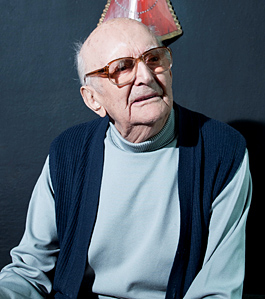
The artist and founder of the Brno Biennale Jan Rajlich has died
 |
Jan Rajlich was born on April 10, 1920, in the village of Dírná in the South Bohemian countryside between Tábor and Jindřichův Hradec as the fourth son of the blacksmith Karel V. Rajlich. He attended high school in Jindřichův Hradec (1930-1939) and Baťa School of Art in Zlín (1939-44). Since 1950, he settled in Brno and worked there first as a painter and graphic artist, soon as a graphic designer and a leading organizer of cultural events. Jan Rajlich became famous in the world as the initiator and long-standing chairman of the International Biennial of Graphic Design in Brno (1963-1992). For his organizational, professional, artistic and journalistic-theoretical contributions to the development of graphic design and visual communications, he received more than forty international awards, including several times being honored by the International Council of Graphic Design Organizations ICOGRADA (1972, 1983, 1985, 2002). In 1995, he received the City of Brno Award not only for his contribution to the cultural development of the city but also for the results of his own artistic creation, which impacted most areas of visual communication design. Since the 1960s, he belonged to the pioneers of theory and practice in the field of visual style and corporate identity for several of our companies (e.g., BVV, hotels Morava Pohořelice, Myslivna Brno), exhibitions, cultural and promotional events, and information systems (Healthcare Center Kohoutovice, shopping centers Javor, Letná and Akát in Bystrc, etc.). He designed posters (more than 300), graphically edited books and catalogs. He collaborated with architects on monumental artistic realizations in architecture (e.g., sgraffito on the facade of the International Hotel in Brno). He worked with Brno Trade Fairs and Exhibitions on exhibition design, developing a unified visual style for BVV. As part of the Biennale Brno 1968, he advocated for the first international exhibition dedicated to exhibition design and a symposium reflecting the successes of our exhibition industry at the World Exhibitions in Brussels '58 and Montreal '67. In free art, he initially focused on painting, later on graphics, in which he concentrated on serigraphy and collages.
As a teacher, he worked at the Brno School of Fine Arts (1964-67). From 1967, he participated in the preparations for the establishment (including program design) of the first higher school of fine arts in Brno, which ultimately was not opened during normalization. From 1983-88, he lectured on graphic design and applied semiotics in postgraduate courses at VŠT Košice and VUT Brno, and from 1992-93, he was at the origin of the Faculty of Fine Arts at VUT, where he served as the first head of the studio of visual communications.
He wrote many articles for domestic and foreign professional journals, and was a long-time external editor of the Japanese magazine IDEA. He summarized his memories of the wartime years at the School of Art in Zlín into the book Trimmed Wings (2005) and the cultural life in Brno into the book Brno - Black White (2015).
He contributed to firmly establishing Brno on the international map of graphic design. He tirelessly created its cultural and historical events. Foreign guests of Biennale Brno will forever remember the unique and friendly atmosphere that he created, supported, and defended with his courage in developing his cultural and artistic activities until his last breath under conditions that were not always favorable to him.
Marta Sylvestrová
Curator of Graphic Design at the Moravian Gallery in Brno
The English translation is powered by AI tool. Switch to Czech to view the original text source.
0 comments
add comment













